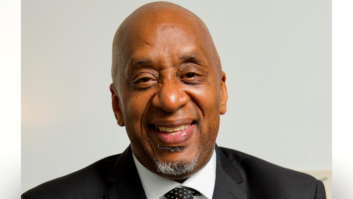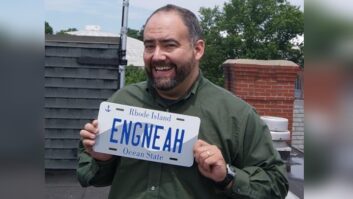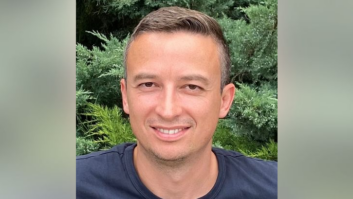
Master control of WYFR, now WRMI, where all of the audio is distributed and computers control transmitters, frequency and antenna changes.
credit: Photo by Thais White, WRMI Many international broadcasters have scaled back their shortwave operations, citing changes in consumer habits, costs of operation and the revolutionary changes brought by the Internet.
So I was interested to learn that the former WYFR in Okeechobee, Fla., described as the largest shortwave facility in the Western Hemisphere, would reopen, as we reported at www.radioworld.com/wyfr.
I reached out to several people involved to learn more.
The first is Jeff White, general manager of Radio Miami International, which has bought the big station from Family Radio and is moving programming and call letters of shortwave station WRMI from Miami to take advantage of Okeechobee’s bigger, more powerful signals.
Family Radio was co-founded by Harold Camping, a prominent radio evangelist known to many in the public for his headline-making predictions of Judgment Day. The organization had shuttered WYFR earlier this year in an apparent cost-cutting move. Camping died in December.
White declined to discuss the purchase details but said Family Radio had been “very generous with us.” I asked how his four staff in Miami would be affected when WRMI’s 50,000-watt Wilkinson AM50,000B transmitter was turned off.
“Our office in Miami will remain open for the foreseeable future. In Okeechobee, we will be employing at least two full-time engineers who have worked with WYFR for nearly 30 years, and probably several other part-time engineers who also worked for WYFR for many years before being laid off in recent months.”
The Okeechobee facility has 13 transmitters, including a dozen 100 kW systems and one 50 kW. It uses 23 antennas that serve the Americas, Europe and Africa. Quite a step up from WRMI’s 50 kW main signal.
White notes that since 1994, WRMI’s primary target areas have been Latin America and North America. “With the Okeechobee facility, we will provide significantly better coverage of these targets due to the more sophisticated antennas — log periodics and double rhomboids with higher gain — and due of course to the higher-powered transmitters. And now we will have the opportunity to broadcast to other parts of the world such as Europe and Africa, which we have never been able to do in a serious way before.”
WRMI originates some of its own programming, including “Viva Miami,” heard in English and Spanish; but most of its airtime is sold to outside organizations. Part of the sale agreement is that the new station will provide Family Radio airtime to transmit programming to the Caribbean and South America. Still, most content will be brought over from existing WRMI.
“The station call letters will change from WYFR to WRMI, and the new facility will air essentially all of the programming currently on WRMI’s transmitter site in Miami,” White said. “This is a diverse mixture of political, religious, musical and cultural programming in English and Spanish, including a number of DX programs intended especially for shortwave listeners.

Transmission lines running from the transmitter building to some of the 23 antennas. Beside the transmitter building, a cow relaxes beside a pond, which it shares with a few alligators.
credit: Photo by Thais White, WRMI “We expect that two hours per day will be Spanish-language programming from Family Radio. About nine hours per day will be English-language religious programming from the Radio Africa network operated by Pan American Broadcasting, based in Pleasanton, Calif. In addition, we will make airtime available to other organizations, including religious organizations.”
White provided me with a historical and technical overview of WYFR that I recommend; I’ve posted it at http://bit.ly/17J3i1Y. It explores the station history dating to the late 1920s and call sign W1XAL, its growth based in New England, its handoff to Family Radio, and a lengthy period of transition to Florida starting in 1977. It also gives technical details about Okeechobee’s high-level plate-modulated transmitters and complex antenna arrays.
GATORS AND SCORPIONS
Jeff White told me he appreciated the help of Dan Elyea, longtime WYFR station engineering manager, now retired, in the agreement.
“Dan presented us to Family Radio Vice President Tom Evans. Tom and the Family Radio board have given us their confidence, and we will do our best to keep this station going for many years to come.” (Evans did not respond to questions I submitted to him for this story.)
So then I touched base with Elyea. He told me he was present at both the birth and demise of WYFR as it existed under those call letters.
“Back in 1973, after serving with radio station ELWA (medium-wave and shortwave) near Monrovia, Liberia, I joined the staff of Family Radio in preparation for the upcoming purchase of WNYW (later to take the call letters WYFR) in Scituate, Mass.,” Elyea wrote me.
“At that time WNYW operated four transmitters and nine reversible rhombic antennas. The property was small, the antennas were marginal; there was no room for expansion. The management of Family Radio located a rural property in Okeechobee County, Fla., that would address numerous shortcomings of the Massachusetts site. In Scituate, I served as chief operator for the station. In October of 1976, I moved to Okeechobee to represent engineering aspects during the construction of the Florida site.”
When operations commenced from Okeechobee, he was appointed engineering manager.
Elyea told me that the site, approximately a mile square, is visited regularly by tropical weather and lightning, while icing, another concern of many an engineer, is not a factor.
Interference is another story.
“A large operation like WYFR draws various complaints of interference,” he wrote, “some legitimate; many not. For a while we were plagued by calls from fire and police departments regarding interference to their walkie-talkie units. These complaints were from out-of-state.
“The comm equipment operated in the VHF range — propagation would not support such a frequency from Okeechobee, yet the complaints kept rolling in. After doing some research, we discovered that the units used an intermediate frequency around 17.8 MHz. And the cases were made of plastic. Our legitimate shortwave transmission was going right through the case and into the IF circuitry. Bad design. Our solution was to declare a range of those frequencies as off-limits for us (based on the IF bandwidth of the units).”
Because Family Radio distributes programming to many locations by satellite, he said, it’s easy to misidentify a source of interference.
“One day in 2008, I got a call from the FCC monitoring station in Vero Beach, Fla. They felt that a potentially interfering transmission was coming from WYFR. It was definitely Family Radio programming. Turns out it was a station in Germany that was carrying Family Radio programming to India. Several times, that same mode brought puzzling accusations that were related to other overseas relay sites.
“Twice FAA engineers descended on our site with vans full of equipment, attempting to identify interfering signals (to aircraft) that they suspected to be WYFR. Many hours of testing later, in each case it was determined that it was another site (once in West Palm Beach, once in Pennsylvania) that was the actual source of the interference.” Same programming, but wrong location source.
You can tell Elyea loves the site. He told me about the creatures that have been seen there. Among them: anhingas, doves, egrets, starlings, sand hill cranes, eagles, hawks, burrowing owls, swifts, quail, rabbits, turtles, ibis, gold silk spiders, black widow spiders, jumping spiders, scorpion, raccoons, armadillo, opossum, foxes, snakes, skunks, alligators, feral pigs, deer and vultures.
He worked there until this summer, when Family Radio shut the doors.
“The closing of WYFR disappointed me greatly,” he reflected. “In many ways my own life was poured into this station for 40 years. Sort of a death-in-the-family feeling. When the possibility for the site to be brought back online by Jeff opened up, I was delighted, and I have been cooperating with Jeff in every way that I can, to assist in making this return to life a reality.”
‘BOLD INITIATIVES’
The buyer, Radio Miami International, was founded in 1989 by Jeff White and the late Kiko Espinosa, its chief engineer.
At first it broadcast via hired airtime but went on the air with its own FCC license in 1994. WRMI currently has a corner reflector antenna beaming 160 degrees toward the Caribbean and Latin America. A yagi-style log periodic antenna beaming 317 degrees toward North America is currently not used. Both of those likely will be scrapped.
White, a former radio news correspondent, also has managed commercial shortwave radio projects Radio Earth in Curaçao, Netherlands Antilles; and Radio Discovery in Santo Domingo, Dominican Republic. He is active in the international shortwave community, currently as secretary-treasurer of the National Association of Shortwave Broadcasters.
He called WYFR an important part of the heritage of shortwave broadcasting. He told me the decision to invest in the facility “is an indication that we believe that shortwave still has a bright future. Things are indeed changing. The major players on the shortwave bands are changing. But that offers new opportunities. And the shortwave receivers and listeners are still there. They have told us that. And they are waiting for bold new programming initiatives, which will be a big challenge for us and everyone else who remains committed to shortwave broadcasting.”
Comment on this or any story. Email to [email protected].







